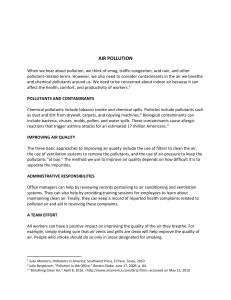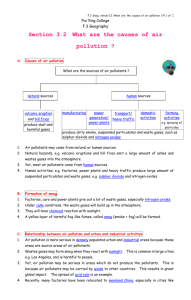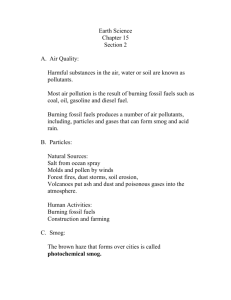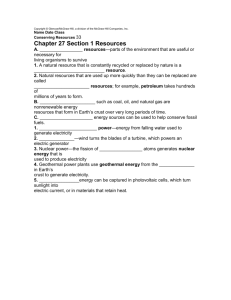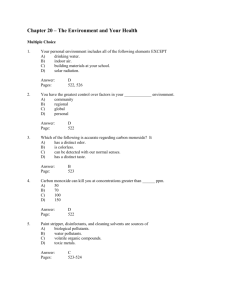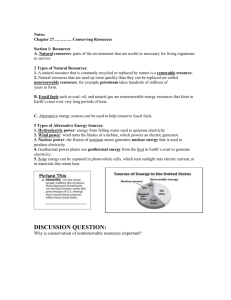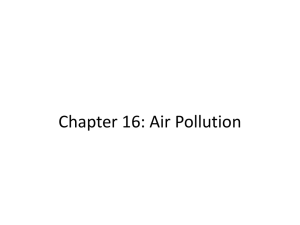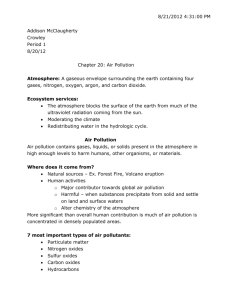Air Pollution: Causes, Effects, and Solutions
advertisement
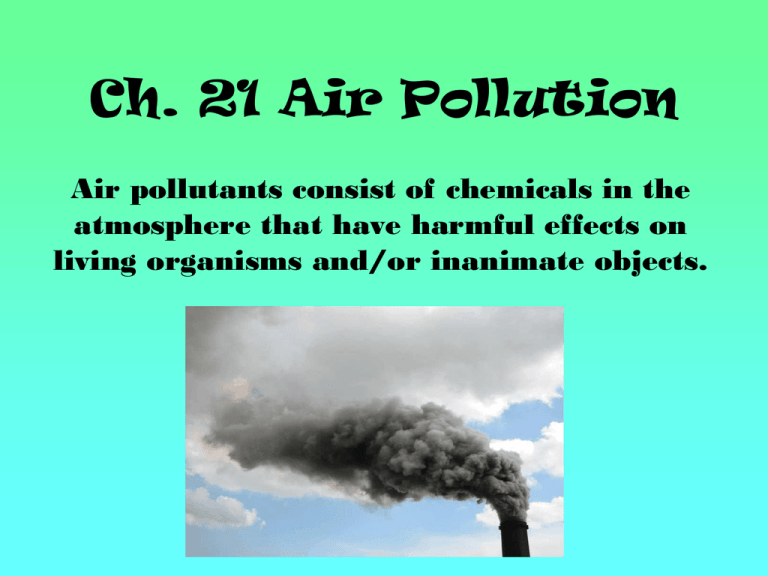
Ch. 21 Air Pollution Air pollutants consist of chemicals in the atmosphere that have harmful effects on living organisms and/or inanimate objects. List of Air Pollutants to know •NOX general form refering to N2O (nitrous oxide), NO2 (nitrogen dioxide), N2O4 (dinitrogen tetroxide), etc. •SOX general form referring to SO2 (sulfur dioxide) and SO3 •CO2 and CO •Acidic biproducts forming acid rain and dry deposits: H2SO4 (sulfuric acid), HNO3 (nitric acid), HC2H3O2 (acetic acid) •Tropospheric ozone O3 Why Do We Care? (humans) • We inhale 20,000 liters of air each day • Causes 150,000 premature deaths in the world each year (53,000 in U.S.); aggravates other diseases • U.S. human health costs from outdoor air pollution range from $40 to $50 billion per year (CDC) • Health impacts - acute – pollutants bring on life-threatening reactions w/in a period of hours or days; causes headache, nausea, irritation - Chronic – pollutants cause gradual deterioration of health over years and low exposure, asthma, allergies, low energy, etc - Carcinogenic – pollutions that causes cancer e.g. benzene - Expansive settles in water ways, bioaccumulation in food chain, effects our nearby ecosystems Why Do We Care? (not human) • Damage to Plants - Agriculture – crops loss ~$5 billion/year - Forests – significant damage to Jeffrey and Ponderosa Pine along Sierra Nevada; tree growth declined 75% in San Bernardino Mountains - suspected to increase plant diseases and pests • Damages buildings, bridges, statues, books • Aesthetics: It looks ugly. We all try to avoid living in polluted areas (admit it…) Major Outdoor Air Pollutants • • 1. 2. 3. 4. 5. 6. Primary – direct products of combustion and evaporation Secondary – when primary pollutants undergo further reactions in atmosphere Suspended particulate matter (primary) Volatile Organic Compounds (secondary) Carbon Monoxide (primary) Nitrogen Oxides (can be both) Sulfur Oxides(primary from combustion of coal) Ozone and other photochemical oxidants (secondary) Acid Deposition • Acidic precipitation and dry fallout both are corrosive and damaging to biota pH scale goes 0 to 14 (acid to base) pH = - log [H+] in a solution. Therefore each number higher on the pH scale is 10X more basic Acidic- produce H+ ions < pH 7 Basic- OH- (hydroxide ions) > pH 7 Neutral- pure water = pH 7 Normal rain slightly acidic-pH 6.4 Acid rain a pH < 5.5 Sources of acid rain Natural: a. Sulfur: Volcanoes, sea spray, microbial b. Nitrogen oxides: lightening, forest fires, microbial Anthropogenic (human caused) a. Sulfur oxides: coal burning plants, industry, fossil fuels. b. Nitrogen oxides: power plants, industrial fuel combustion, transportation c. Effect areas hundreds of miles from the source of emissions, generally not the whole globe d. Both sulfur oxides and nitrogen oxides are primary components of acid rain. Indoor Air Pollutants 1. Types: benzene, formaldehyde, radon, cigarette smoke 2. Sources: off gassing from furniture, rugs and building materials, dry cleaning, adhesives, cleaning fluids, disinfectants, pesticides, heaters 3. Buildings with too many indoor air pollutants are called “sick buildings” because more than 20% of the people are sick due to occupying the building. Sick Building Syndrome on EPA website Indicators of SBS include: Building occupants complain of symptoms associated with acute discomfort, e.g., headache; eye, nose, or throat irritation; dry cough; dry or itchy skin; dizziness and nausea; difficulty in concentrating; fatigue; and sensitivity to odors. And most of the complainants report relief soon after leaving the building. Causes of Sick Building Syndrome The following have been cited causes of or contributing factors to sick building syndrome: • Inadequate ventilation: As a result of the 1973 oil embargo, national energy conservation measures called for a reduction in the amount of outdoor air provided for ventilation to 5 cubic feet per minute per occupant (used to be 15 cfm per occupant). After many SBS cases, the standard is now back up to 15cfm per occupant minimum and more for specialized situations. • Chemical contaminants from indoor sources: adhesives, carpeting, upholstery, manufactured wood products, copy machines, pesticides, and cleaning agents may emit volatile organic compounds (VOCs), including formaldehyde. Combustion products such as carbon monoxide, nitrogen dioxide, as well as respirable particles, can come from unvented kerosene and gas space heaters, woodstoves, fireplaces and gas stoves. • Chemical contaminants from outdoor sources: The outdoor air that enters a building can be a source of indoor air pollution. For example, pollutants from motor vehicle exhausts; plumbing vents, and building exhausts (e.g., bathrooms and kitchens) can enter the building through poorly located air intake vents, windows, and other openings. • Biological contaminants: Bacteria, molds, pollen, and viruses are types of biological contaminants. These contaminants may breed in stagnant water that has accumulated in ducts, humidifiers and drain pans, or where water has collected on ceiling tiles, carpeting, or insulation. Sometimes insects or bird droppings can be a source of biological contaminants. Physical symptoms related to biological contamination include cough, chest tightness, fever, chills, muscle aches, and allergic responses such as mucous membrane irritation and upper respiratory congestion. Solutions to SBS: pollutant source removal, increasing ventilation rates, air cleaning/filtering, communication and education Reducing Air Pollutant Emissions Best way = Conservation, just use less! • Reducing pollution from transportation Input Control (pollution prevention) a. Cleaner burning gasoline, remove lead Pb which was used as an antiknock substance b. increased fuel efficiency c. alternative modes of transportation -Mass transit, Walking, Bicycling, Electric vehicles d. decrease the number of miles driven Reducing Air Pollutant Emissions (input control) e. changes in land use decisions f. catalytic converter- complete oxidation of hydrocarbons (VOCs) and carbon monoxide to CO2 and H2O, makes for less the VOC and CO pollutants Output Pollution Control a) Scrubbers on smoke stacks b) taller stacks to allow for cooling and condensation c) Coal washing-using large amount of H2O to get rid of sulfur before burning d) Fluidized bed combustionproduces a waste ash that must be disposed of Reducing Pollution from Electricity Production • Input Control (pollution prevention) A. Cleaner Burning Fuel by… -Switching to low-sulfur coal -Switching from coal to natural gas -Switching from fossil fuel to renewable energy source B. Increase Energy Efficiency by… -using insulation - using more efficient appliances Output Control Technologies Technological fixes to remove air pollutants • Scrubbers are “liquid filters”: exhaust fumes through a spray of H2O containing lime • Also use elctrostatic precipators: SO2 CaSO3 to precipitate out • Required since 1977 in part due to Clean Air Act of 1970 Air Pollutions Problems and Progress • Incinerators: used to burn waste, used to do this in open air with no exhaust filtering, very harmful • Smelting: a form of metallurgy used in mining to heat/melt and add electrolysis to molten ore to isolate the desired mineral/metal • Since removal of lead from car gasoline, levels of Pb found in the environment, in animals and humans has been reduced significantly. • In 1960s biggest source of air pollution was factories and industry. But since Clean Air Acts of 1970 and 1990, they have been regulated and there has been a decrease in atmospheric concentrations of VOCs, SOx, CO, NOx and particulate matter (soot, smoke). • Today biggest source of air pollution is transportation, vehicles. • A few years ago, China surpassed the USA as being the highest emitter of carbon dioxide. And the Asia/Pacific region is a bigger carbon dioxide emitting region than North America.
